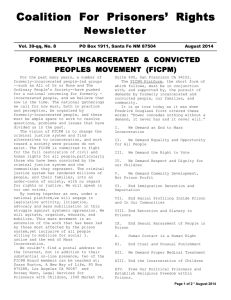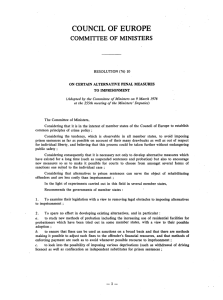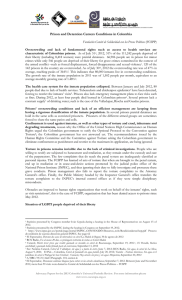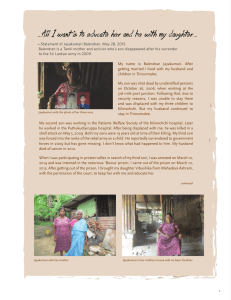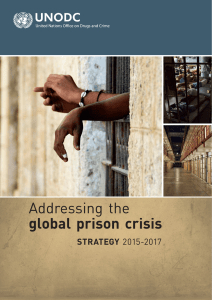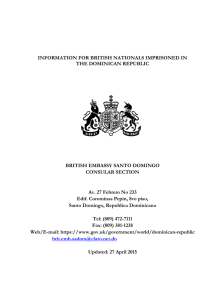WOMEN`S IMPRISONMENT: AN INTRODUCTION TO THE
Anuncio
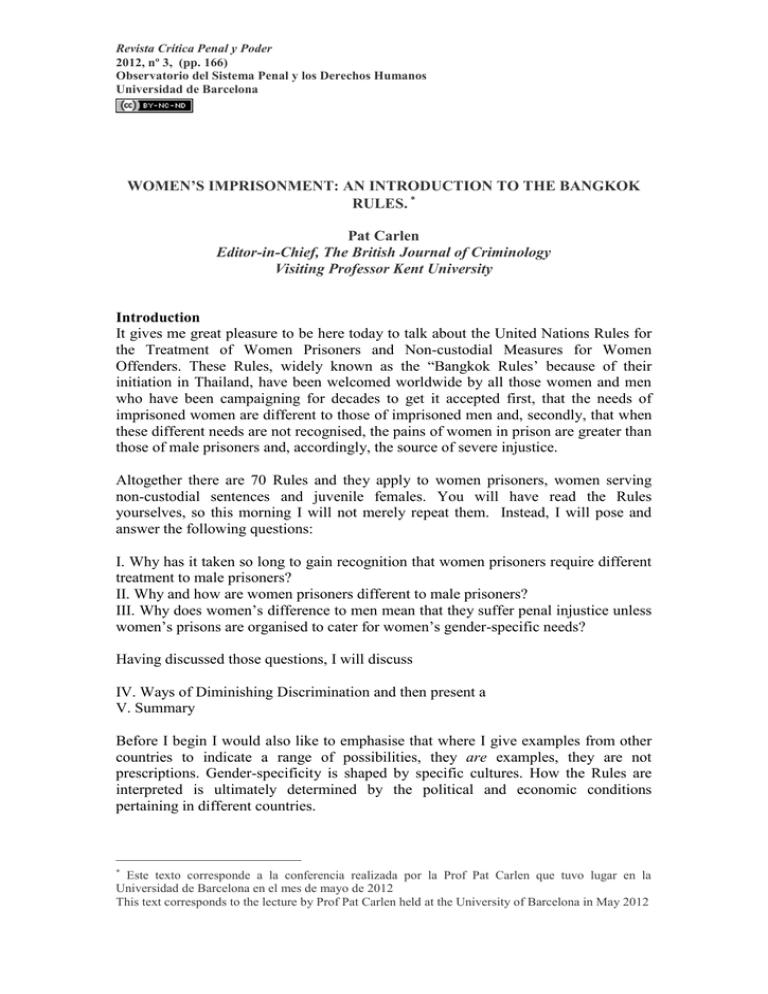
Revista Crítica Penal y Poder 2012, nº 3, (pp. 166) Observatorio del Sistema Penal y los Derechos Humanos Universidad de Barcelona WOMEN’S IMPRISONMENT: AN INTRODUCTION TO THE BANGKOK RULES. Pat Carlen Editor-in-Chief, The British Journal of Criminology Visiting Professor Kent University Introduction It gives me great pleasure to be here today to talk about the United Nations Rules for the Treatment of Women Prisoners and Non-custodial Measures for Women Offenders. These Rules, widely known as the “Bangkok Rules’ because of their initiation in Thailand, have been welcomed worldwide by all those women and men who have been campaigning for decades to get it accepted first, that the needs of imprisoned women are different to those of imprisoned men and, secondly, that when these different needs are not recognised, the pains of women in prison are greater than those of male prisoners and, accordingly, the source of severe injustice. Altogether there are 70 Rules and they apply to women prisoners, women serving non-custodial sentences and juvenile females. You will have read the Rules yourselves, so this morning I will not merely repeat them. Instead, I will pose and answer the following questions: I. Why has it taken so long to gain recognition that women prisoners require different treatment to male prisoners? II. Why and how are women prisoners different to male prisoners? III. Why does women’s difference to men mean that they suffer penal injustice unless women’s prisons are organised to cater for women’s gender-specific needs? Having discussed those questions, I will discuss IV. Ways of Diminishing Discrimination and then present a V. Summary Before I begin I would also like to emphasise that where I give examples from other countries to indicate a range of possibilities, they are examples, they are not prescriptions. Gender-specificity is shaped by specific cultures. How the Rules are interpreted is ultimately determined by the political and economic conditions pertaining in different countries. Este texto corresponde a la conferencia realizada por la Prof Pat Carlen que tuvo lugar en la Universidad de Barcelona en el mes de mayo de 2012 This text corresponds to the lecture by Prof Pat Carlen held at the University of Barcelona in May 2012 Pat Carlen I Why has it taken so long to gain recognition that women prisoners require different treatment to male prisoners? 1. Relatively small numbers of women in custody People have always known that women prisoners are different to male prisoners, but one of the reasons why it has taken hundreds of years for women’s difference to be officially recognised is because women constitute a very small percentage of prison populations, only between 2 and 9 percent in most jurisdictions worldwide. This statistic also reflects the fact that women commit less crime and less serious crime than men. The resultant low numbers of women in trouble with the police and courts have resulted in women as a group being invisible in the criminal justice and penal systems, and in women being incarcerated in prisons designed by men and for men. Because there are relatively small numbers of women in the criminal and penal systems, there is a narrower range of non- custodial and custodial facilities for women. This has had the following undesirable results. Very young women are frequently, and unacceptably, imprisoned with much older women. Women are remanded in custody or sentenced to imprisonment when their male counterparts would not have been imprisoned, solely because there are no noncustodial facilities for women When women are released from prison they are forced to return to unsafe conditions because no transitional prisons or other through-care facilities are available. Even when women’s difference has been recognised by governments, the cost of making facilities available for the very small numbers of women (who are very often very dispersed geographically) is frequently used as an excuse for inaction. Additionally there have been equity concerns. 2. Equity Concerns Governments and prison authorities unwilling to make different provision for women prisoners have repeatedly invoked the principle that all prisoners should be treated equally and that to treat women differently would be unfair to male prisoners. However, equality of treatment of prisoners does not mean that they should all be treated as if their needs and basic requirements are the same. When the differences between people are not recognised, the same treatment has unequal impact on different groups of people. Of course prison regimes cannot cater for each person’s individual mix of needs (though equally compelling arguments could be made for greater recognition of the special needs of mentally and physically impaired people, ethnic minorities, foreign nationals, refugees in detention and other minority groups). None the less, the universal and most all-encompassing difference between people is gender: at both the biological and cultural levels. If gender differences are not recognised, then the pains of imprisonment impact differently on males and females. It is a basic contention of gender specific arguments that when gender differences are not recognised in prisons, and all other things are equal, the pains of imprisonment suffered by women are greater than those suffered by men. Thus, non-recognition of difference does not result in equality of treatment, it results in unfair treatment of the group whose different needs are not recognised. That this is so is not only of concern Revista Crítica Penal y Poder. 2012, nº 3, septiembre (pp. 148-157) OSPDH. Universidad de Barcelona 149 Women’s imprisonment: an introduction to the Bangkok Rules at a jurisprudential level (concerning the quality of criminal and gender justice) it is also of concern because in all societies women are still the primary carers of children. 3. Women in Prison are seen as Doubly Deviant A corollary to the ‘invisibility’ of women in the criminal justice system has been that those women who do appear in courts and get sent to prison have traditionally been seen as being very bad indeed, as being ‘doubly deviant’, as being not only bad citizens (they have broken the law) but also as ‘unnatural women’. It is presumed that they have offended against their femininity and are bad wives, mothers and daughters. In fact, women in many jurisdictions are sent to prison for less serious crimes than men, and overall are likely to be in greater poverty, in worse health and having suffered much more as victims of sexual abuse and violence than men. A typical pathway into crime for young women, is to be turned out of home after being abused by a male family member and then to turn to drugs and prostitution in order to survive on the streets. Courts then send them to prison because there is nowhere else for them to go. But once they get to prison, it is assumed that as so relatively few women go to prison, they must be very bad indeed – and that provides prison authorities with further excuse for believing that nothing can or should be done to enable the women to live law-abiding lives once they leave prison. As a result the same women are returned to prison again and again, each new imprisonment where nothing at all is done to help them ensuring that when they leave they are much more vulnerable to crime and custody than when they were last imprisoned. II. Women Prisoners’ Difference Biological Difference. Women prisoners have different biological needs to men. Menstruation, childbirth and menopause result in them requiring specialised medical care at different times in their lives and therefore prison regimes need to be organised so that at these times they can rest, wash and have all the specialised diet and care that is necessary for their own health and the health of any children in prison with them. Most prison regimes make some provision for pregnant women, childbirth and nursing mothers. Opinion is divided as to whether imprisoned women should have their babies with them beyond 18 months of age. However, when women are menstruating, pregnant, giving birth, nursing infants or passing through the menopause they have special needs (emotional, mental and physical) and it is in this area that some of the worst treatment of women in prison has occurred - (I give you some examples from the UK) heavily pregnant women have been made to do such heavy work that they have miscarried; women in labour have been shackled to the bed; nursing mothers have not received appropriate diet; mothers who are breastfeeding have had their babies taken away from them as a punishment for some minor breach of prison rules; and women whose babies have been still-born have not been allowed to attend their funerals. Cultural Difference Even though women’s different biological needs are too frequently not catered for in prisons organised for men, it is never denied that women are biologically different to men. Less universally recognised however is that the backgrounds, socialisation and lived experiences of women prisoners are significantly different to those of men, and that because women in most societies are still discriminated against in terms of material goods and power, when they go to prison, Revista Crítica Penal y Poder. 2012, nº 3, septiembre (pp. 148-157) OSPDH. Universidad de Barcelona 150 Pat Carlen they carry with them a heavier burden of care and anxiety than their male counterparts, and these material and cultural deficits impinge upon and aggravate their experience of imprisonment from the first day until the last. Let’s look at some of the main dimensions of women’s cultural difference. 1. Women are still the main child carers Because women bear and rear children, mothers in prison are made to feel more guilty than fathers in prison. Additionally, they worry more about their children’s welfare and fear that they will lose their children altogether – that they will be taken away from them by other family members or the state – or they are scared that some harm will come to them. Sometimes women’s pain is made worse by guards verbally abusing them by calling them bad mothers for being in prison. Moreover, it is frequently observed that imprisoned men are visited in prison much more frequently by their female partners than imprisoned women are visited by their male partners. 2. The backgrounds of women prisoners are likely to be more complex and poverty-stricken than those of male prisoners. This is because often women are sent to prison not because of the seriousness of their crimes, but rather because their personal circumstances are such that there is nowhere else for them to go. 3. Women are more likely to have suffered physical and sexual abuse than men prior to imprisonment, and generally to be in worse health, both physically and mentally. A higher proportion of them will have attempted to commit suicide prior to their imprisonment and will be especially vulnerable in the days immediately after admission. 4. Different standards of sexual presentation and behaviour are required of women outside prison. In most societies women are expected to keep their sexual parts covered. Women therefore can suffer immense humiliation (or anger) when strip-searched or required to undress or perform natural functions in front of others, especially men. 5. Gender stereotyping of women is likely to result in more limited prison regimes for women and also harsher disciplinary standards. The stereotyping of women as the ‘gentler sex’ can result in higher standards of behaviour being expected of women prisoners, with the result that they are punished for breaking petty rules. Yet, at the same time women prisoners usually have a more restricted access to sport or other exercise. When they are released from prison the stigma of imprisonment stays with women longer than it does with men and upon release from prison women are likely to be much more vulnerable to homelessness, violent men, sexual abuse and a return to drugs. III. Implications for Women in the Courts and Prisons 1. Women should be given non-custodial sentences whenever possible: they should not be imprisoned for their own protection, they should not be imprisoned because there are no appropriate non-custodial facilities, nor should they be imprisoned in any other circumstances where a male would not be imprisoned. Revista Crítica Penal y Poder. 2012, nº 3, septiembre (pp. 148-157) OSPDH. Universidad de Barcelona 151 Women’s imprisonment: an introduction to the Bangkok Rules 2. Women whose crimes are too serious for a non-custodial penalty should be imprisoned as close to their homes as possible and allowed to make provision for their dependent children prior to their imprisonment. 3. Women prisoners should be housed separately from men to avoid the risk of sexual abuse, and because high proportions of both men and women prisoners have reported that some of their troubles outside prison have been related to the opposite sex. 4. The living areas in women’s prisons should be staffed by women and, unless emergency treatment is required, medical staff should also be female. 5. All aspects of the women’s prisons should be gender-tested to ensure that women are not disadvantaged by a gender stereotyping that result in them having fewer opportunities for education, sport, and all aspects of personal development than male prisoners. 6. Transport to prisons should be appropriate to women prisoners’ state of health and a female guard should be in attendance. 7. Women should be assessed immediately upon their arrival in prison. Assessment should relate to their state of health – physical and mental - and also to the numbers, present location and provision for any dependent children. However, their right to refuse screening in relation to their reproductive health should also be recognised. Non-medical staff should not be present during medical examinations unless there is a security issue or the prisoner has asked for a non-medical member of staff to be present. With the prisoner’s permission, families should be informed of the present location of women prisoners. 8. Assessment of women’s likely housing needs upon release should begin as soon as they enter prison. Research has indicated that in many jurisdictions safe and secure housing is the No 1 material need for imprisoned women. Upon access to safe and secure housing depends the safety of whole families, the women’s ability to look after their families and their ability to get work and other social goods. 9. Gender-specific and individualised provision in terms of healthcare, diet and un-stressful regimes should be available for all women prisoners and especially for pregnant women and nursing mothers. Women prisoners should have access to the same gender-specific health facilities which they would have available to them in the community outside prison. Where such facilities are universally available outside the prison they should be available within the prison. 10. Investigation should be made to discover whether women are victims of sexual or physical abuse and they should be informed of their rights to prosecute their attackers. Special protective measures should be made available to women who avail themselves of this right. 11. Sensitive and peer-based education about HIV and AIDS should be available. Revista Crítica Penal y Poder. 2012, nº 3, septiembre (pp. 148-157) OSPDH. Universidad de Barcelona 152 Pat Carlen 12. Search and restraint procedures should protect women’s modesty. Women should not be searched or restrained by men, or have to suffer invasive search procedures. 13. Facilities should be available for women prisoners to maintain contact with their children and other family members. Yet, although there is a great deal of emphasis on family ties in the Rules, it should also be recognised that because so many women have suffered physical and sexual abuse in the family, not all wish to be in contact with families. Additionally, some prisoners may be of a lesbian sexual orientation and this should be respected. All prisoners should therefore be consulted about who should be allowed to visit them. 14. Provision for babies in prison should cater for babies’ developmental needs in terms of healthcare, diet, stimulating toys and activities and fresh air. If fathers are not visiting, care should be taken that the baby sees men and hears male voices. Several jurisdictions house mothers and babies in entirely separate buildings. So that a baby doesn’t have the stigma of being born in prison, mothers should be transferred to an outside hospital for the birth. 15. Prison staff should be trained in women’s special needs. It is often said that women prisoners are more difficult to manage than male prisoners. But it should be remembered that women used to running families do not easily adapt to living in communal conditions where they are regimented. Women prisoners should be provided with activities which allow them some responsibility over how they spend their time, and where they can engage in decision making and getting, or maintaining, control over their own lives. 16. Research has found that often women in prison have low self-esteem. Activities should be provided that help women to cope with depression, difficulties in living such as relationship problems. 17. Lack of Support for Released Women. A major issue around the world is that however gender-aware prison staff are, and however much rehabilitative work is done inside prison, when women come out of prison, there is very little for them to be rehabilitated to. Most of them had very little before they went into prison and most of them have even less when they come out. It is for this reason that imprisonment should be used very seldom for both men and women. It is essential that women who are imprisoned should receive support upon release and it is especially important for women who are hoping to give up drugs. Because of the small-numbers, provision for women should never be used for men, and should be kept for women, however few women at any particular time need it. 18. Prison staff should also be made aware that gender needs vary by ethnicity and that some indigenous peoples and some foreign nationals may find some aspects of a prison regime against their religion or customs, and therefore suffer more pain, as well as isolation as a result of language difficulties. Provision should therefore be made to meet the particular gender-specific needs of foreign national women (e.g. they may require different religious and dietary provision, different. Revista Crítica Penal y Poder. 2012, nº 3, septiembre (pp. 148-157) OSPDH. Universidad de Barcelona 153 Women’s imprisonment: an introduction to the Bangkok Rules Where possible, women should be transferred to their home countries as soon as possible. Should also apply to refuge women in detention) 19. Research, staff training and public education in gender –specific needs should be an ongoing process. Staff in women’s prisons should have same access to promotion as staff in men’s prisons. IV. Diminishing Discrimination: Commentary on Rules So that’s what the Rules recommend. What steps can be taken to diminish discrimination. Well, different countries have different starting points and are taking different routes to achieving more gender specific prisons for women. There is no universal map. So I will end by looking at some typical issues that various countries have had to address as they have attempted to make the criminal justice system more women-wise and the treatment of women in prison appropriate to women’s different biological and cultural needs. Two Jurisprudential Issues Equity In some jurisdictions there have been concerns about the perceived inequity of giving a woman a more lenient sentence or more privileged custodial conditions because she is a mother. This objection to the implementation of different regimes for women tends to have been countered by campaigning groups who have argued that women pose so much less risk than men, they are a low risk group to use for experimental non-custodial projects which could then be attended to low risk men. The argument has also been used that women should be spared imprisonment in the interest of their families. But there are dangers with that argument… Whose Rights? A related jurisprudential issue has concerned the question of whose rights and interests are being most protected when a baby is kept in prison with its mother? e.g. what about if the father or other family members object? The general consensus seems to be that when a mother goes to prison it is the interest of the baby which should be paramount, and, indeed, that it is in everyone’s interest for the interest of the baby to be paramount. BUT, although this at first sight appears to be an obvious precept, it can become problematical when issues of prison discipline arise; or when the suitability of a mother for a mother and baby unit is called into question. What there does seem to be agreement about is that there should be no pressure on a mother who has made an informed decision not to have her baby in prison with her. It is also widely assumed that babies should not suffer the stigma of being born in prison and that a mother in labour should be transferred to an outside hospital for the labour and the birth. If, for unavoidable reasons the baby is born in prison, the baby should not have the prison recorded on the birth certificate as being the place of birth. Inter-Agency Issues Criminal justice and penal policy is so complex that whenever there is policy change many different agencies have to be persuaded to change their organisational cultures and their working practices. Prisons themselves, being relatively closed institutions, often present special difficulties. One of the major problems affecting women in Revista Crítica Penal y Poder. 2012, nº 3, septiembre (pp. 148-157) OSPDH. Universidad de Barcelona 154 Pat Carlen prison concerns communications with agencies outside the prison. Often provision for mothers and babies in prison (and upon release) is fragmented, and the work of one agency often undermines that of another (e.g. children ‘lost’ in system, delays in procedure etc). The following ideas have been put forward to address the difficulty: Women’s courts. Now that it is generally recognised that the needs of female offenders, and especially those of nursing mothers, are very different from men’s, it has been suggested that separate courts for women could provide a co-ordinated and specialised approach to the provision of women's often very complex needs, and especially mothers’ and young girls’ needs. Drugs courts, for instance, have been especially successful in co-ordinating police activity in relation to prosecutions, referrals and warrants and a specialist court for women might result in one-stop provision of resources for women (for example, legal, medical, social, probation, child-minding). Now, it could be argued that poor men coming out of prison have similarly complex needs. True. What makes women’s situation so much more complex is first that so many of them have children as well as themselves to care for, and that as women alone they are more vulnerable than men to physical and sexual abuse. One stop Provision for Released Prisoners. Similarly, when women are released from prison, it has been found that they are more likely to receive the care they need if housing, legal, education, welfare and children’s resources are all in one place. Interagency forums at which people from the relevant agencies meet and exchange information and policy changes are also essential to keep all the different agencies appraised of the general policy of diverting women from custody. It is especially important to get the police involved, to ensure that their actions are not working against any general policies. It is also important for different agencies to appreciate the different roles and legal requirements placed on each other agency. Women’s Policy Director. In England the founding of a women’s policy unit with its own Director was responsible for a big change in women’s prisons. The Bangkok Rules recommend that prison inspection teams inspecting women’s prisons should always have female members as part of the Inspectorate. In England it was found that it was necessary also to have a separate director of women’s prisons to ensure that policy changes were actually implemented (though implementation was, and continues to be, incomplete). Community Issues It is been found that it is advisable to get community support for any changes in imprisonment. The following strategies have been adopted: Education. Educate the public about especial problems of women in prison and mothers in prison in particular. The public are usually sensitive to the argument that women prisoners’ children should not be disadvantaged by their mother’s crimes. Revista Crítica Penal y Poder. 2012, nº 3, septiembre (pp. 148-157) OSPDH. Universidad de Barcelona 155 Women’s imprisonment: an introduction to the Bangkok Rules Volunteers. Train and use volunteers to liaise between imprisoned mothers and their families (e.g. USA, South Africa). Spreading knowledge about women prisoners and their families is often the most effective way to address misleading stereotypes of women prisoners. Mentors in Prison. Within prisons involve prisoners and ex-prisoners in mentoring, support groups (e.g. train them as ‘Listeners’) and in public education projects via dance and drama, personal testimonies (UK). Invite outside groups into the prison. Mentors for Rehabilitation. The Israeli Rehabilitation Authority has inaugurated a system of mentors or adopted families for those who do not have supportive family ties. Prison Open Days for business leaders, magistrates, judges, civic leaders, church leaders, women’s groups, trade unions, employers, media and other opinion leaders are held in the UK and USA. Family days: have been introduced in prisons in New Zealand. At a prison which I visited in Peru, children were allowed to come into the prison to eat the dinners which their mothers had cooked for them – a reminder of how important it is that siblings outside prison be prepared for the return of the mother with a new baby. Remaining Issues. I would like to conclude by mentioning three further issues which have had to be addressed by practitioners attempting to implement gender-specific regimes for women. Questions of raising unrealistic expectations of mothers in Prison. In England there has sometimes been an argument that mothers in prison have a standard of living in prison which they cannot maintain outside. In reply it has been argued that increased facilities for mothers in prison must be seen as part of general support to families in the community and not as an alternative. One has to ask the question: What kind of society is it when people have to go to prison to received the basic standard of living which they should have received outside and which, if they had received it, might have enabled them to stay out of crime and out of prison? Net-widening Danger: Another problem that has arisen in the UK is that when prisons are known to be making better treatment provision for drug users than is available outside prison, some judges have sent female drug users to prison not because of the actual seriousness of their crimes but so that they can receive treatment for their addictions. This happens regularly in the UK. A journal article praised a drugs project in Holloway Women’s Prison in London and probation officers reported that for weeks afterwards, magistrates were asking them whether women should be sent to Holloway to get drugs treatment. (Happens with homeless young girls, pregnant women, mentally ill and other women seen to be vulnerable in some way.) The general view in Europe is that women should only be sent to prison as a last Revista Crítica Penal y Poder. 2012, nº 3, septiembre (pp. 148-157) OSPDH. Universidad de Barcelona 156 Pat Carlen resort and that addictions treatment, and any other protective intervention is more successful when it takes place in a community, rather than a custodial setting. Prisoner Fathers, Husbands and Partners. Soon after attempting implementation of gender-specific programmes in UK, it was recognised that there was little point in educating women to resist male abuse and engage in good childcare practice if they were to return to male partners who were still committed to the same patterns of abuse and who were maybe not used to being parents. Parenting classes have therefore been started in some male prisons. In other jurisdictions fathers are invited into prisons to undertake parenting classes with their wives. So to summarise: 1. The main reason why it was necessary for the United Nations to adopt special Rules for women’s imprisonment is that because women are different to men both biologically and culturally, they suffer disproportionately when they are held in prisons devised for men and which therefore have not, historically taken account of women’s difference. Therefore all aspects of women’s prisons should be gendertested to ensure that they are appropriate to women’s biological and cultural needs. 2. Because of women’s roles as mothers, and also because their crimes tend to be less serious than men’s, the general recommendation is that women and juvenile females should not be given custodial sentences but should be dealt with by non-custodial measures. 3. Courts should ensure that women and juvenile females are only given custodial sentences because of the seriousness of their crimes, and not according to the courts’ assessment of them as wives, mothers and daughters. I hope you have found this useful. In England we are a long way from getting it right and sexist practices in relation to women in the criminal justice system and the prisons continue – even though our independent inspectorate ensures that they are regularly brought to public attention. Gender specific prison reform in most countries is uneven. In the UK there has been a constant struggle to keep a watch on the prisons, and check that once old sexist practices have been abandoned they do not creep back. In the last couple of decades in the UK, a generally more punitive attitude to crime has resulted in such overcrowding in the prisons that many official reform strategies in relation to gender-testing and gender sensitive regimes have remained at the level of rhetoric rather than being put into practice – and I know that the same has happened in other countries. So, and as you will know, the most important approach to prison reform is to routinely monitor prisons so that knowledge of what is going on behind the prison walls is constantly updated. In UK we have an independent prison inspectorate – and it is truly independent. None the less, non-implementation of prisoners’ rights and minimum conditions still occurs for three main reasons: failure of central government to sufficiently fund minimum conditions; prison overcrowding; and staff failure to implement improvements because of feeling that prisons should be more punitive. It seems to me that until independent inspectorate staff are employed in prisons as compliance officers, prisoners’ rights will only be implemented in a fragmentary way. Revista Crítica Penal y Poder. 2012, nº 3, septiembre (pp. 148-157) OSPDH. Universidad de Barcelona 157
